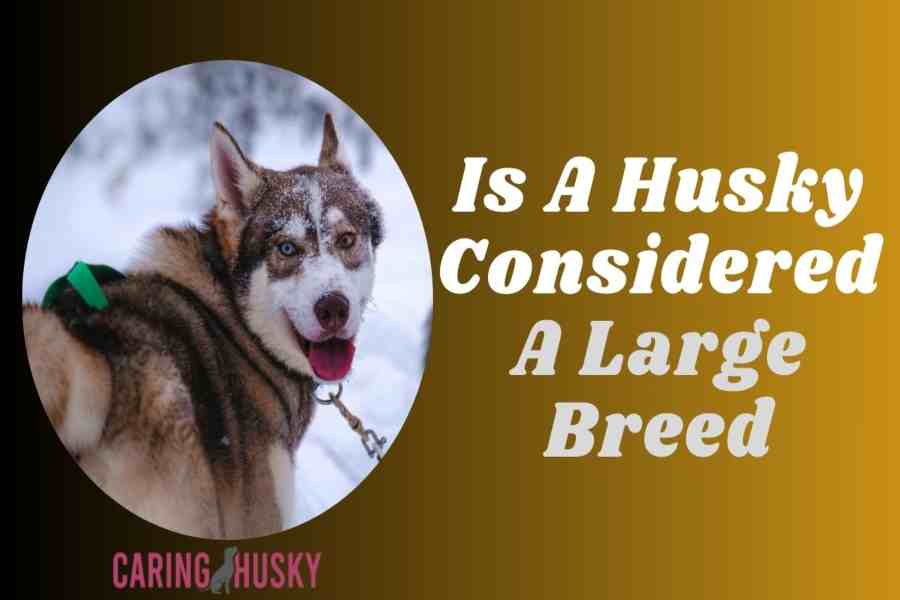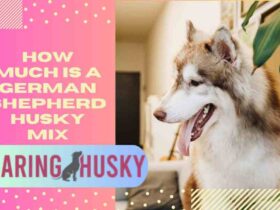In the diverse realm of dog breeds, size plays a pivotal role in characterizing these four-legged companions. The Siberian Husky, with its striking appearance and wolf-like features, often leaves people wondering about its classification. is a husky a large breed? In this concise blog post, we’ll unravel the mystery surrounding the Siberian Husky’s size. Delving into its history, physical characteristics, and temperament, we’ll determine whether this breed truly qualifies as a large one or falls into a different category. Join us on this brief exploration of the Siberian Husky’s stature, and by the end, you’ll have a clear understanding of where this remarkable breed stands on the scale of canine dimensions.
Is a Husky Considered a Large Breed?
Yes, a Husky is generally considered a medium to large breed. Male Huskies typically stand 21 to 24 inches tall at the shoulder and weigh 45 to 60 pounds, while females are slightly smaller. Perception may vary, but they are not classified as small dogs.
Understanding Husky Size And Its Importance
Huskies, known for their striking appearance and friendly demeanor, are medium to large dog breeds. Their size matters for various reasons, influencing the responsibilities and considerations of Husky ownership.
Knowing a Husky’s size is crucial for proper care. Male Huskies stand 21-24 inches tall, weighing 45-60 pounds, while females are slightly smaller. Their medium to large size calls for ample space, regular exercise, and a balanced diet.
Husky size also impacts social interactions. Owners need to ensure they are well-trained and socialized to avoid any issues with other animals or people due to their robust build and energetic nature.
Additionally, grooming demands vary with size. Huskies’ double coat, whether they appear large or medium-sized, requires regular maintenance to prevent matting and excessive shedding.
What Is The Maximum Size Of A Siberian Husky?
A Siberian Husky usually grows to be about 20 to 24 inches tall at the shoulder. That’s about as tall as the handlebars on a kid’s bike. They weigh around 35 to 60 pounds, which is almost as heavy as a big bag of dog food. Huskies are medium-sized dogs, not too big and not too small.
It’s important to note that there can be variations in size among individual Huskies, and factors like genetics, diet, and overall health can influence their growth and size. Female Huskies are often slightly smaller than males, but this can also vary.
Keep in mind that proper nutrition and exercise during their growth stages, typically in the first year or two of life, are essential for a Husky’s overall health and development. If you have a specific concern about your Husky’s size or growth, consulting with a veterinarian can provide valuable guidance and ensure your dog is on a healthy growth trajectory.
Factors That Affecting Husky Breed
The size of a Husky, like that of any dog breed, is influenced by several key factors. Understanding these factors can provide insight into the variability of Husky sizes and help prospective owners make informed decisions.
1. Genetics:
Genetics plays a significant role in determining a Husky’s size. The size of a Husky’s parents can be a strong indicator of the size their offspring will attain. Breeders often select for specific size traits within their breeding programs.
2. Breed Standards:
The American Kennel Club (AKC) sets breed standards for Huskies, specifying the acceptable height and weight ranges. Responsible breeders strive to adhere to these standards when producing Husky puppies.
3. Diet and Nutrition:
Proper nutrition during a Husky’s growth stages can impact their final size. Overfeeding or underfeeding can lead to size variations and potential health issues.
4. Health and Wellness:
A Husky’s overall health and well-being can influence their size. Puppies that experience health challenges during their formative months may not reach their full-size potential.
5. Exercise and Activity Level:
The amount of exercise and physical activity a Husky receives during their development can affect muscle tone and overall size perception.
6. Spaying/Neutering:
The timing of spaying or neutering can also influence a Husky’s growth. Early spaying/neutering may result in slightly smaller dogs compared to those spayed/neutered later.
7. Gender:
Male Huskies are generally larger than females, although there can be exceptions. Gender is a natural factor influencing size differences within the breed.
8. Age:
Huskies continue to grow and fill out until they reach maturity, typically around 18 months to 2 years of age. This means that younger Huskies may appear smaller compared to their adult size.
Husky size is subject to a combination of genetic, environmental, and lifestyle factors. While breed standards provide a general guideline, individual Huskies can vary in size within those standards. Husky owners need to provide proper care, nutrition, and exercise to ensure their dogs reach their full, healthy
The Origins Of The Siberian Husky
The Siberian Husky, often simply referred to as the Husky, is a breed of dog with a rich and fascinating history that dates back to ancient times. Here’s an overview of the history of the Siberian Husky:
1. Origins in Siberia:
The Siberian Husky’s roots can be traced to the Chukchi people, an indigenous group living in the Siberian Arctic. These dogs were originally bred by the Chukchi for their ability to pull sleds over long distances in harsh Arctic conditions. The Chukchi valued these dogs for their strength, endurance, and friendly temperament.
2. Arrival in North America:
In the early 20th century, Siberian Huskies were introduced to Alaska and North America. They were primarily brought to North America for use in sled dog racing and Arctic exploration. The All-Alaska Sweepstakes sled dog race in 1909, which was won by a team of Siberian Huskies, helped to establish the breed’s reputation for speed and endurance.
3. Role in the Nome Serum Run:
One of the most famous events in the history of the Siberian Husky was their involvement in the 1925 Nome Serum Run, also known as the “Great Race of Mercy.” During a diphtheria outbreak in Nome, Alaska, a relay of dog teams, including Siberian Huskies, transported life-saving serum over 600 miles in treacherous conditions to save the town’s inhabitants. This heroic effort brought international attention to the breed’s capabilities.
4. Recognition and Popularity:
The Siberian Husky was officially recognized by the American Kennel Club (AKC) in 1930. Over the years, their popularity grew, not only as working sled dogs but also as beloved pets and show dogs.
5. Contributions to Exploration:
Siberian Huskies played a crucial role in several Arctic expeditions, including those led by Admiral Richard Byrd and Rear Admiral Richard E. Peary. Their ability to thrive in extreme cold and pull heavy loads made them invaluable in these endeavors.
6. Modern Huskies:
Today, Siberian Huskies are known for their striking appearance, friendly disposition, and continued use in dog sledding, recreational mushing, and various dog sports. They are a popular breed worldwide, admired for their endurance, intelligence, and adaptability.
The Siberian Husky’s history is deeply intertwined with the indigenous people of Siberia and their need for reliable sled dogs in harsh Arctic conditions. From their origins in Siberia to their fame in Alaska and beyond, Huskies have left an indelible mark on the world, both as working dogs and as beloved companions.
Considerations For Husky Ownership
Owning a Siberian Husky is a rewarding experience, but it comes with its own set of unique considerations. Before bringing one of these beautiful and spirited dogs into your life, there are several factors to ponder:
- Exercise Requirements: Huskies are highly energetic dogs bred for endurance. They thrive on daily exercise, and a lack of physical activity can lead to behavioral issues. Be prepared for long walks, runs, or even sled-pulling activities to keep them content.
- Climate: Huskies have a thick double coat designed for cold climates. They may struggle in hot, humid weather. Ensure they have access to shade and water during warm months.
- Grooming: Their thick fur requires regular brushing to prevent matting. Huskies also shed profusely, especially during seasonal changes.
- Socialization: These dogs are generally friendly but need early socialization to prevent aggressive behavior. There may be better choices for homes with small pets due to their strong prey drive.
- Training: Huskies are intelligent but can be independent and stubborn. Consistent, positive reinforcement-based training is essential to keep them well-behaved.
- Escape Artists: Huskies are notorious escape artists. They have a strong desire to roam and explore. Secure fencing and supervision are crucial to prevent them from wandering.
- Time Commitment: Huskies thrive on human companionship. They can suffer from separation anxiety if left alone for extended periods. Consider your daily schedule and availability.
- Health Care: Be prepared for routine veterinary care, including vaccinations, regular check-ups, and potential breed-specific health issues.
- Cost: Owning a Husky can be expensive. Consider the costs of food, grooming, veterinary care, and any potential emergencies.
- Lifestyle: Assess your lifestyle and living situation. Huskies are best suited for active families or individuals who can meet their exercise needs and provide ample mental stimulation.
While Siberian Huskies make incredible companions for the right owners, they require a commitment to their unique needs. Ensure you have the time, energy, and resources to provide a loving and fulfilling home for these remarkable dogs.
Conclusion
Siberian Huskies are an unusual and captivating breed, despite being one of the smallest dog breeds. Their well-balanced medium-sized height, ranging from 35 to 60 pounds, reflects their agility and strength. These canines are well-known for their distinctive looks and lively dispositions, making them a popular option among dog owners. Potential Husky owners, on the other hand, should be informed of the breed’s specific requirements, which include plenty of activity, grooming, and socializing. Siberian Huskies thrive in busy houses and form close relationships with their human partners. While they may not be giants in size, their distinguishing characteristics, such as loyalty and perseverance, greatly transcend any concerns about their size. Siberian Huskies may be valued family members for people who are ready to satisfy their demands.
FAQ’s
Is a Husky a medium or large dog?
A Husky is typically considered a medium-sized dog, characterized by its strong build and moderate size, fitting neither into small nor large dog categories.
Is Husky considered a large breed for food?
No, a Husky is not usually considered a large breed for food purposes. They are medium-sized dogs, so their diet and portion sizes are generally aligned with medium-breed nutritional guidelines.
What category is a Husky?
A Husky falls into the working dog category. This group includes breeds that are traditionally used for tasks like pulling sleds, guarding, or rescue operations. Huskies are known for their strength and endurance.
What is a full-breed Husky?
A full-breed Husky, often referred to as a purebred Husky, is a dog that belongs exclusively to the Siberian Husky breed without any mix from other dog breeds. They have specific characteristics and lineage that conform to the standards set for Siberian Huskies.






Leave a Reply